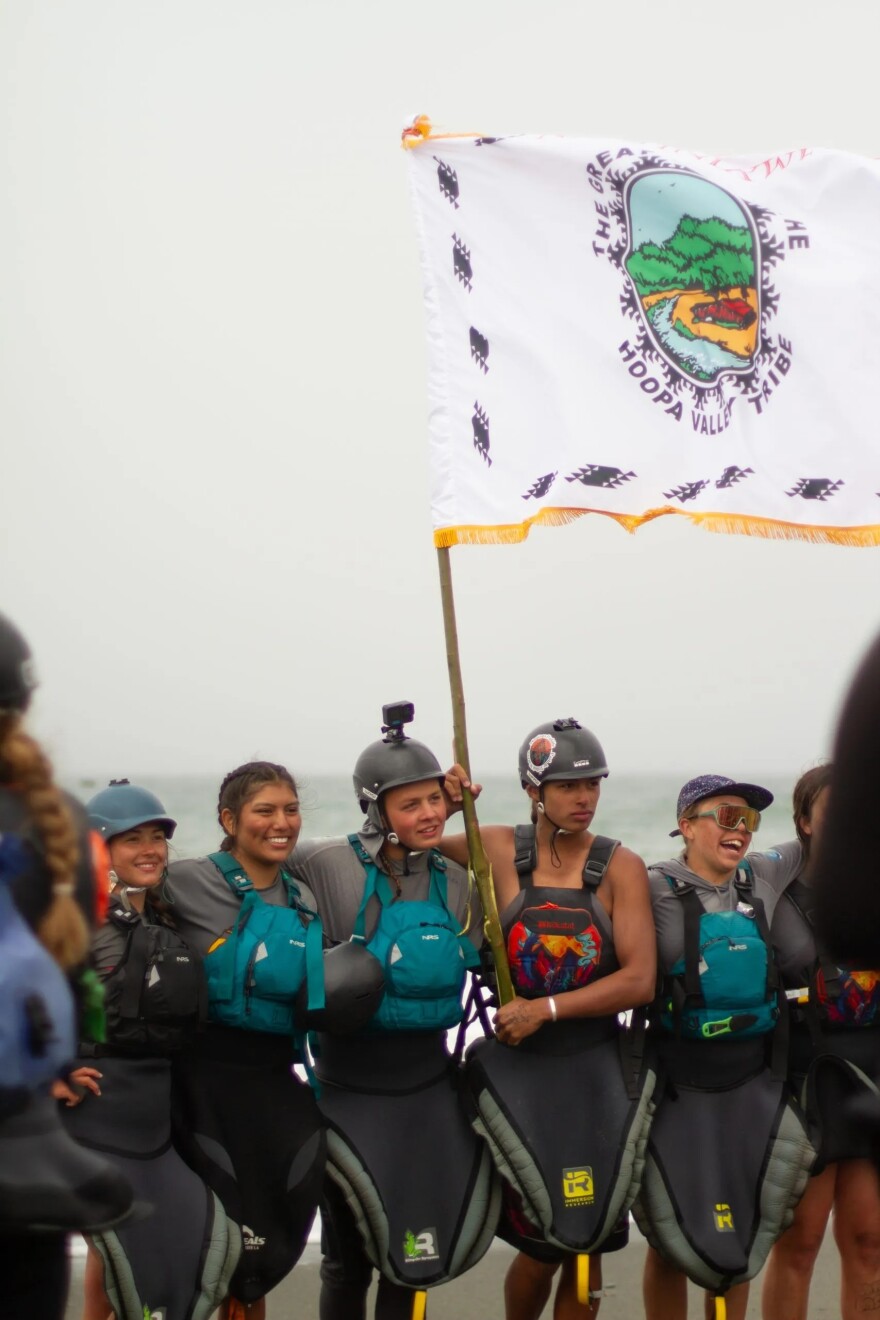This story originally appeared on Underscore Native News
Over a hundred family and community members gathered on the sand spit shore below Requa Village on the Yurok Reservation, where the Klamath River meets the Pacific Ocean, to welcome 120 Indigenous youth kayakers over that last 30 days, making history as the first people to descend over 310 miles down the free-flowing Klamath River.
“This is a historical moment for us,” said Susan Masten, former Yurok Tribal Chair, past president of the National Congress of American Indians, and the president and co-founder of Women Empowering Women for Indian Nations. “We haven’t had the opportunity yet to celebrate the dams coming down as a people.”
“This moment in time, with these youth that have traveled 30 days, the river has guided them down to us,” said Masten.

It was a foggy morning as Masten stood on the beach, eagerly awaiting to welcome her niece and the other kayakers.
For more than a century, four hydroelectric dams blocked the Klamath River, disrupting once-abundant salmon runs and disconnecting Indigenous communities from the river that they have lived along since time immemorial. The last of those dams were removed in the fall of last year, marking the completion of the largest dam removal project in history.
“The most significant and important thing about it is that the river is healing,” said Masten.
“The river remembers,” she added.“The fish are coming back to spawn where they haven’t been able to be in a hundred years plus. The fish remember. We, as this river system, are healing.”

On June 12, the young kayakers ranging in age from 13 to 20 set out to paddle the newly free-flowing river at the headwaters in southern Oregon, and on July 11, they made the long-awaited dream of the Klamath basin tribes a reality once they entered the mouth of the river. Youth from the Klamath, Yurok, Karuk, Quartz Valley, Hoopa Valley, Warm Springs as well as the Tohono O’odham Nation were represented in the program.
“There have been generations of individuals and tribes who have been fighting this fight,” said Masten. “Our ancestors have provided safety for them on their journey. We’re just excited and want them to feel like we’re honoring them, because they have provided international and national attention to our river and the importance of having a free flowing river. They have inspired millions to be advocating and fighting for their own rivers and their homelands.”

More than three years of preparation led to this moment, as youth traveled to places like Chile, Costa Rica, Canada and Africa to train and learn how to navigate whitewater with kayak instructors from the Paddle Tribal Waters program, part of the nonprofit Ríos to Rivers.
As mothers helped their children dress into traditional Yurok regalia—deerskin skirts adorned with rows of abalone and shells, placing Yurok hat baskets atop their heads, and more– the sound of drums and songs blended with the cheers of those on shore as the bright neon-colored kayaks emerged from the fog, led by two traditional Redwood dugout canoes.
“I look up and I see so many family members there, and so many community members and my grandparents and everybody, and someone who’s like my uncle singing his song and drumming for us, and I was like, ‘Oh my gosh. We’re actually about to finish this. We actually did it,” said Danielle Frank, Hupa tribal member and Yurok descendant, Director of Development and Community Relations for Ríos to Rivers.
“It felt very scenic and very deep,” said Frank, “like the river and the world was having this deep moment, welcoming us into this historic time and place.”

Smiles lit the faces of the kayakers as they reached the shore. They immediately jumped from their kayaks and sprinted through the lines of cheering people to the crashing waves of the Pacific Ocean.
“It’s just a big moment in history, and in everybody’s lives,” said 20-year-old Isqotsxoyan Scott, of the Hupa Valley Tribe, as she tried to catch her breath after celebrating in the ocean with the others. “All of our families have been fighting for dam removal. Everybody’s been fighting for us to be able to reach different parts of the rivers that we haven’t been able to in over 150 years. So it’s really so much, I can’t even explain how I feel right now.”
On the beach, one elder was overcome with emotion watching the youth kayakers. She apologized to the people standing next to her. They told her that “No, we can cry grandma. Crying is part of it. Crying is healing.”
After the landing, everyone jumped in kayaks, rafts and boats to join tribal elders, community members and family at the boat dock for a celebration. Youth and representatives took turns sharing about their experiences.
“It’s not just a river trip and it’s not just a descent to us,” said Frank in her speech. “This whole trip is really a letter to our community. It’s a letter of love– the love that has been shown to us our entire lives, the love we get to show to each other and ourselves that was wrapped into this trip. That’s what built this trip, was knowing that we were loved enough to be supported to do something like this.”

“It’s also a letter of promise,” Frank continued, “We promise that we will do whatever we have to, to protect our free-flowing river now.”
Underscore Native News is a nonprofit newsroom committed to Indigenous-centered reporting in the Pacific Northwest. We are supported by foundations and donor contributions. Follow us on Facebook, Instagram, TikTok, YouTube and Bluesky.


